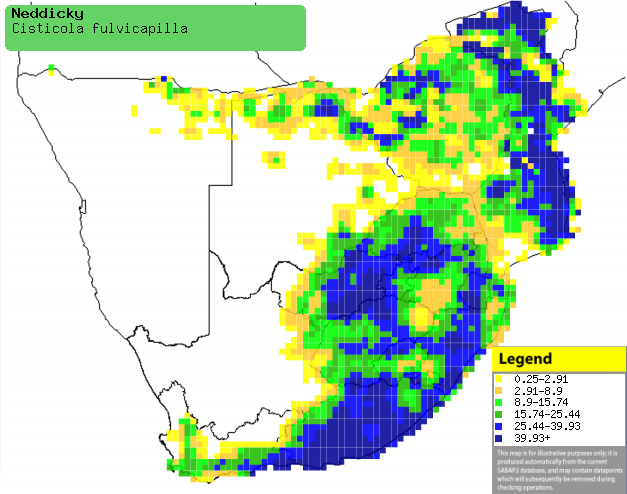|
Cisticola fulvicapilla (Neddicky)
Neddikkie [Afrikaans]; Incede [Xhosa]; iNcede, uQoyi
[Zulu]; Harudeve (generic term for cisticola or prinia) [Kwangali]; Motintinyane
(generic term for cisticolas and prinias) [South Sotho]; Kadhi-idhi-i, Timba
(generic names for cisticola) [Shona]; Matinti (generic term for cisticola)
[Tsonga]; Bruinkop-graszanger [Dutch]; Cisticole à couronne rousse [French];
Brauner zistensänger [German]; Fuinha-de-cabeça-ruiva [Portuguese]
Life
> Eukaryotes >
Opisthokonta
> Metazoa (animals) >
Bilateria >
Deuterostomia > Chordata >
Craniata > Vertebrata (vertebrates) > Gnathostomata (jawed
vertebrates) > Teleostomi (teleost fish) > Osteichthyes (bony fish) > Class:
Sarcopterygii (lobe-finned
fish) > Stegocephalia (terrestrial
vertebrates) > Tetrapoda
(four-legged vertebrates) > Reptiliomorpha > Amniota >
Reptilia (reptiles) >
Romeriida > Diapsida > Archosauromorpha > Archosauria >
Dinosauria
(dinosaurs) > Saurischia > Theropoda (bipedal predatory dinosaurs) >
Coelurosauria > Maniraptora > Aves
(birds) >
Order: Passeriformes > Family: Cisticolidae
> Genus: Cisticola
Distribution and habitat
It occurs from southern Tanzania, Angola and Zambia to
southern Africa. Here it is locally common in many areas excluding arid Karoo,
savanna and the Namib Desert, but otherwise occurring in a variety of habitats.
It generally prefers Broad-leaved burkea (Burkea africana) woodland,
thorny savanna, forest edges, fynbos, renosterbos, scrub on boulder-strewn
slopes, gardens with thick vegetation and the grassy understorey of alien tree
plantations.
|
 |
|
Distribution of Neddicky in southern Africa,
based on statistical smoothing of the records from first SA Bird Atlas
Project (©
Animal Demography unit, University of
Cape Town; smoothing by Birgit Erni and Francesca Little). Colours range
from dark blue (most common) through to yellow (least common).
See here for the latest distribution
from the SABAP2. |
Brood parasites
It has been recorded as host of the
Brown-backed honeyguide.
Food
It mainly eats insects, doing most of its foraging on the
ground the ground beneath undergrowth, hopping after flying or jumping insects. The following food items have been recorded
in its diet:
- Insects
- Nectar
- Aloe marlothii (Mountain aloe)
- Aloe greatheadii (Spotted aloe)
Breeding
- The nest is built solely by the female, and is typically an oval or ball
shape with a side entrance, although it may rarely construct a cup instead.
It builds it out of dry grass secured with spider web, with the female
adding a soft plant down lining to the inside and also to below the side
entrance (forming a kind of doormat). It is usually placed low down in a
grass tuft, herb or forb, very near to the ground surface.
- Egg-laying season is from September-March, peaking from October-January.
- It lays 2-5 eggs, which are incubated for about 12-15 days.
- The chicks leave the nest after about 12-15 days.
Threats
Not threatened.
References
-
Hockey PAR, Dean WRJ and Ryan PG 2005. Roberts
- Birds of southern Africa, VIIth ed. The Trustees of the John Voelcker
Bird Book Fund, Cape Town.
|
